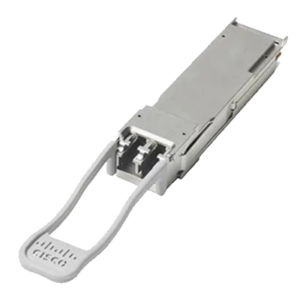When the IEEE introduced the 802.3ba Ethernet standard in June 2010, this was in response to the increasing bandwidth demands facing data centers, paving the way for the introduction of 40Gb/s and 100Gb/s Ethernet operations. Just a few years later, users of this technology are still relatively isolated but continue to increase as network operators need the highest data rates over a single connection. As you begin to think about the future of your network, understanding all the 40GbE and 100GbE optical components can be confusing. Curvature has put together a brief overview of the current 40GbE and 100GbE optics types and form factors to aid in planning for future high-performance Ethernet needs.
Module Types
QSFP/QSFP28
QSFP form factor optics are the primary way of delivering 40GbE and are now appearing in 100GbE in QSFP28 form. These present either MPO or LC connectors.
- QSFP28 is a new variant published to support 100Gb. QSFP and QSFP28 are both the same form factor.
- LC Variants are also available on Bi-Directional (BiDi) Multi-Mode QSFPs allowing QSFPs to use existing OM3/OM4 multi-mode fiber plants
- MPO variants are also available for (some) Single-Mode QSFP transceivers used to breakout 1x MPO/MTP port to multiple LC connections
- *Multi-Mode QSFP transceivers typically support a breakout mode as well.
CFP
CFP form factor optics are available in 40GbE and 100GbE varieties. These present MPO connectors for multi-mode optics or SC connectors for single-mode optics.
- Important to note that the CFP is an older standard. The Notes mentioned above don’t really apply to the CFPs. The QSFP/QSFP28 standard not only provides a smaller form factor, but the different variants add flexibility to continue using some of the older 10Gb fiber standards without having to replace fiber plants.
CFP2
The CFP2 is an evolution of the existing CFP form factor, using manufacturing and optics advances to reduce the size of the module to approximately half that of the original CFP.
- Though the CFP has increased This is quickly becoming a legacy optic as well. Cisco only has a handful of devices that support these. Quickly being replaced by the QSFP28 standard.
- At the time of its release, the CFP2 was known to increase interface density because of the smaller size and lower power consumption. However, the QSFP standard is the ideal choice for higher interface density applications.
CPAK
The CPAK is a Cisco-proprietary form factor developed in order to provide a more power and space-efficient 100GbE optic compared to the CFP or CFP2 modules, especially for long-reach optics such as 100GBase-LR4.
- The CPAK standard is similar to the CFP2 in size and power consumption.
Converters and Breakout Cables
Most 40GbE ports are capable of running in a 4x 10GbE mode, allowing for easy 10GbE/40GbE mixed media deployments. These ports can also provide the option of ultra-high 10GbE port density (for example, a Nexus 3016 can be configured to present 64 total 10GbE ports, which is more than what can fit in 1RU when presented as SFP+ ports). For QSFP-based systems, this is accomplished using either a special direct attach cable with 1x QSFP on one end and 4x SFP+ on the other end, or an SR4 optic with a custom MPO to 8x LC cable. For Cisco products that use CFP-based 40GbE, such as the WS-X6904-40G parts, Cisco makes the CVR-CFP-4SFP10G converter that changes the CFP slot into four SFP+ slots.
Multimode Optics
Cabling Considerations
Current multi-mode optics standards for 40GbE and 100GbE optics use multiple 10Gbps lasers, simultaneously transmitting across multiple fiber strands to achieve high data rates. Because of the multi-lane nature of these optics, both 40GbE and 100GbE multi-mode optics use a different style of fiber cabling, known as MPO or MTP cabling. An MPO/MTP cable presents 12 separate strands of multi-mode fiber in a single ribbon cable. As with 10GbE optics over multi-mode fiber, an OM3 or OM4 grade MMF is needed to be able to cover longer distances (up to 150m).
*LC Variants are also available on Bi-Directional (BiDi) Multi-Mode QSFPs allowing QSFPs to use existing OM3/OM4 multi-mode fiber plants
 |
Products | Type | Connector Type |
| QSFP-40G-SR4-S | 40GBASE-SR4, 4 lanes, 850 nm MMF | MPO-12 | |
| QSFP-40G-SR4 | 40GBASE-SR4, 4 lanes, 850 nm MMF | MPO-12 | |
| QSFP-40G-SR-BD | 40GBASE-SR-BiDi, duplex MMF | LC |
Direct Attach Cables
As with 10GbE optics, there are direct attach copper cables available for 40GbE and 100GbE optics when short distance (within the same rack) cabling runs are all that are needed. Passive cables are available in the standard one-, three-, and five-meter lengths. Active cables are also available for longer runs.
Request a quote
MPO Connector
40GBase-SR4
40GBase-SR4 optics use a single MPO ribbon cable for both transmit and receive, as SR4 uses four strands for transmit and four strands for receive. Maximum distance depends on the type of multimode fiber used.
| Wavelength (nm) | Cable Type | Core Size (Microns) | Modal Bandwidth (MHz*km) | Cable Distance | |
| 40GBase-SR4 | 850 | MMF | 50.0 50.0 50.0 |
2000 (OM3) 4700 (OM4) |
30m 100m 150m |
100GBase-SR10
100GBase-SR10 optics use a 24 strand MPO cable for connectivity: ten strands for transmit and ten strands for receive. Because each individual lane uses the same laser type as 40GBase-SR4, maximum distances are identical, as seen below.
| Wavelength (nm) | Cable Type | Core Size (Microns) | Modal Bandwidth (MHz*km) | Cable Distance | |
| 100GBase-SR10 | 850 | MMF | 50.0 50.0 |
2000 (OM3) 4700 (OM4) |
100m 150m |
100GBase-SR4
100GBase-SR4 optics use 4 fibers for transmit and 4 for receive, with each lane providing 25Gbps of throughput. 100GBase-SR4, like 40GBase-SR4, uses a 12 fiber MPO cable with 4 strands for transmit and 4 for receive, allowing for existing 40GBase-SR4 fiber assemblies to be reused when higher performance is needed. This interface standard has been introduced alongside the 100Gbps QSFP offerings now arriving on the market in order to make any 40GbE to 100GbE upgrade as seamless as possible.
Single-mode Optics
40GBase-LR4
40GBase-LR4 optics use the same multi-lane technology as SR4 optics, with one exception. Instead of using a single fiber strand for each lane, WDM technology is used to multiplex all four transmit lanes onto one strand of fiber and all four receive lanes onto another single strand of fiber, allowing any existing single-mode fiber installation to be used. Because of this, standard LC (for QSFP modules) or SC (for CFP modules) connections are used, allowing for an easy upgrade from a 10GbE connection.
| Transmit Power (dBm) | Receive Power (dBm) | Transmit and Receive Wavelength (nm) | Cable Distance | |||
| Max. | Min. | Max. | Min. | Four Lanes | ||
| 40GBase-LR4 1310nm SMF |
2.3 per lane | -7.0 per lane | 2.3 per lane | -13.7 per lane | 1271, 1291, 1311, 1331 | 10km |
40GBase-FR
40GBase-FR is a single-laser technology, best used in environments where multi-lane optics isn’t a workable option due to fiber quality or the nature of the data being sent. (There are internal load-balancing algorithms for multi-lane optics that don’t always work optimally.) However, distance is somewhat limited in comparison to the LR4.
| Transmit Power (dBm) | Receive Power (dBm) | Transmit and Receive Wavelength (nm) | Cable Distance | |||
| Max. | Min. | Max. | Min. | Four Lanes | ||
| 40GBase-LR4 |
3.0 per lane | 0.0 per lane | 3.0 per lane | -6.0 per lane | 1530 to 1565 | 2km |
100GBase-LR4
Like 40GBase-LR4, the 100GBase-LR4 is a multilane optic. However, each lane’s data rate is increased to 25Gbps to achieve the full 100Gbps data rate.
| Transmit Power (dBm) | Receive Power (dBm) | Transmit and Receive Wavelength (nm) | Cable Distance | |||
| Max. | Min. | Max. | Min. | Four Lanes | ||
| 100GBase-LR4 |
4.5 per lane | -4.3 per lane | 4.5 per lane | -10.6 per lane | 1295.6nm, 1300.1nm 1304.6nm, 1309.1nm |
2km |
If you liked what you read in this tech guide, you might also enjoy our blog post, Third-Party Optical Transceivers Innovation for Your Bottom Line


